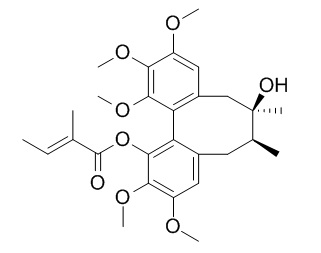Tigloylgomisin H
Tigloylgomisin H represents a potential liver cancer prevention agent, it can significantly induce quinone reductase (QR) activity in Hepa1c1c7 mouse hepatocarcinoma cells, it functions as a novel monofunctional inducer that specifically upregulates phase II enzymes through the Nrf2-ARE pathway.
Inquire / Order:
manager@chemfaces.com
Technical Inquiries:
service@chemfaces.com
Tel:
+86-27-84237783
Fax:
+86-27-84254680
Address:
1 Building, No. 83, CheCheng Rd., Wuhan Economic and Technological Development Zone, Wuhan, Hubei 430056, PRC
Providing storage is as stated on the product vial and the vial is kept tightly sealed, the product can be stored for up to
24 months(2-8C).
Wherever possible, you should prepare and use solutions on the same day. However, if you need to make up stock solutions in advance, we recommend that you store the solution as aliquots in tightly sealed vials at -20C. Generally, these will be useable for up to two weeks. Before use, and prior to opening the vial we recommend that you allow your product to equilibrate to room temperature for at least 1 hour.
Need more advice on solubility, usage and handling? Please email to: service@chemfaces.com
The packaging of the product may have turned upside down during transportation, resulting in the natural compounds adhering to the neck or cap of the vial. take the vial out of its packaging and gently shake to let the compounds fall to the bottom of the vial. for liquid products, centrifuge at 200-500 RPM to gather the liquid at the bottom of the vial. try to avoid loss or contamination during handling.
Molecules.2023, 28(13):4972.
J of the Korean Society of Food Science and Nutrition2019, 32(2):148-154
Photodermatol Photoimmunol Photomed.2024, 40(1):e12950.
Korea Institute of Oriental Medicine2020, doi: 10.21203.
Evid Based Complement Alternat Med.2021, 2021:5023536.
J Chromatogr B Analyt Technol Biomed Life Sci. 2017, 1064:115-123
Saf Health Work.2019, 10(2):196-204
J Biomol Struct Dyn.2022, 1-21.
Phytomedicine.2022, 100:154058.
Fitoterapia.2024, 175:105958.
Related and Featured Products
Planta Med. 2009 Oct;75(12):1314-8.
Induction of the phase II detoxification enzyme NQO1 in hepatocarcinoma cells by lignans from the fruit of Schisandra chinensis through nuclear accumulation of Nrf2.[Pubmed:
19452436]
The upregulation of phase II detoxification genes is believed to play an important role in cancer prevention. The molecular mechanism underlying the changes in gene expression that accompany cancer prevention involves activation of the transcription factor, NF-E2-related factor 2 (Nrf2). In traditional medicine, the fruit of Schisandra chinensis Baill is used as a tonic, an anti-tussive and an anti-aging drug.
METHODS AND RESULTS:
In the current study, nine lignans were isolated from S. chinensis and tested for their ability to induce quinone reductase (QR) activity in Hepa1c1c7 mouse hepatocarcinoma cells. Tigloylgomisin H (TGH) and angeloylgomisin H (AGH) significantly induced QR activity and exhibited a relatively high chemoprevention index (CI) (10.80 and 4.59, respectively) as compared to control. TGH also induced QR activity in BPrc1 mouse hepatocarcinoma cells as well, which are defective in aryl hydrocarbon nuclear translocator (Arnt). In HepG2 human hepatocarcinoma cells, TGH significantly activated gene expression mediated by the antioxidant response element (ARE), a key regulatory region in the promoters of detoxification enzymes, through the nuclear accumulation of Nrf2.
CONCLUSIONS:
The results of the current study suggest that TGH functions as a novel monofunctional inducer that specifically upregulates phase II enzymes through the Nrf2-ARE pathway. TGH thus represents a potential liver cancer prevention agent.
J Sep Sci. 2012 Sep;35(17):2203-9.
Application of ultrahigh-performance liquid chromatography coupled with mass spectrometry for analysis of lignans and quality control of Fructus Schisandrae chinensis.[Pubmed:
22814992]
Lignans in the drug Fructus Schisandrae chinensis (FSC) exhibit potent biological activities such as antihepatotoxic, antiasthmatic, and antigastric ulcer.
METHODS AND RESULTS:
An ultrahigh-performance liquid chromatography coupled with quadrupole time-of-flight mass spectrometry method has been developed to evaluate the quality of FSC through simultaneous qualitative and quantitative analysis of 15 lignans, including schizandrin A, B, and C; schizandrol A and B; gomisin B, C, D, E, G, H, J, and N; Tigloylgomisin H; and angeloylgomisin H. The compounds were separated on a Zorbax Eclipse Plus C(18) (2.1 × 100 mm, 1.8 μm) column with a gradient elution of acetonitrile and 0.1% formic acid. Lignans were identified through their retention times, accurate mass data, and characteristic ions by comparison with a reference substance. All calibration curves showed perfect linear regression (r(2) > 0.99) within the test range. The limits of detection and quantitation fell in the ranges of 0.1-4 ng/mL for all the analytes with an injection of 10 μL. Good results were obtained with respect to repeatability (relative standard deviation <4.6%) and recovery (85.58-105.82%). Meanwhile, the entire sample analysis time was less than 10 min.
CONCLUSIONS:
This developed method provided a new basis for the overall assessment of the quality of FSC.



